Criminology Analysis: Crime, Law, and Media's Influence on Perception
VerifiedAdded on 2023/04/22
|14
|4122
|370
Essay
AI Summary
This criminology essay delves into the multifaceted definition of crime, exploring its legal, social, and ethical dimensions. It examines how crime is defined by law, influenced by societal norms, and perceived through the lens of mass media. The essay critically analyzes the role of media in shaping public perception of crime, highlighting the potential for distortion, exaggeration, and sensationalism. It discusses the concept of 'crime waves' and the impact of news values on crime reporting, noting how media often prioritizes newsworthiness over trustworthiness. The essay further explores how media representations can create moral panics and influence public opinion, while also acknowledging the evolving media landscape and the increasing sophistication of media audiences. Ultimately, it underscores the complex relationship between crime, law, and media in contemporary society, with Desklib offering further resources for students to explore these topics.
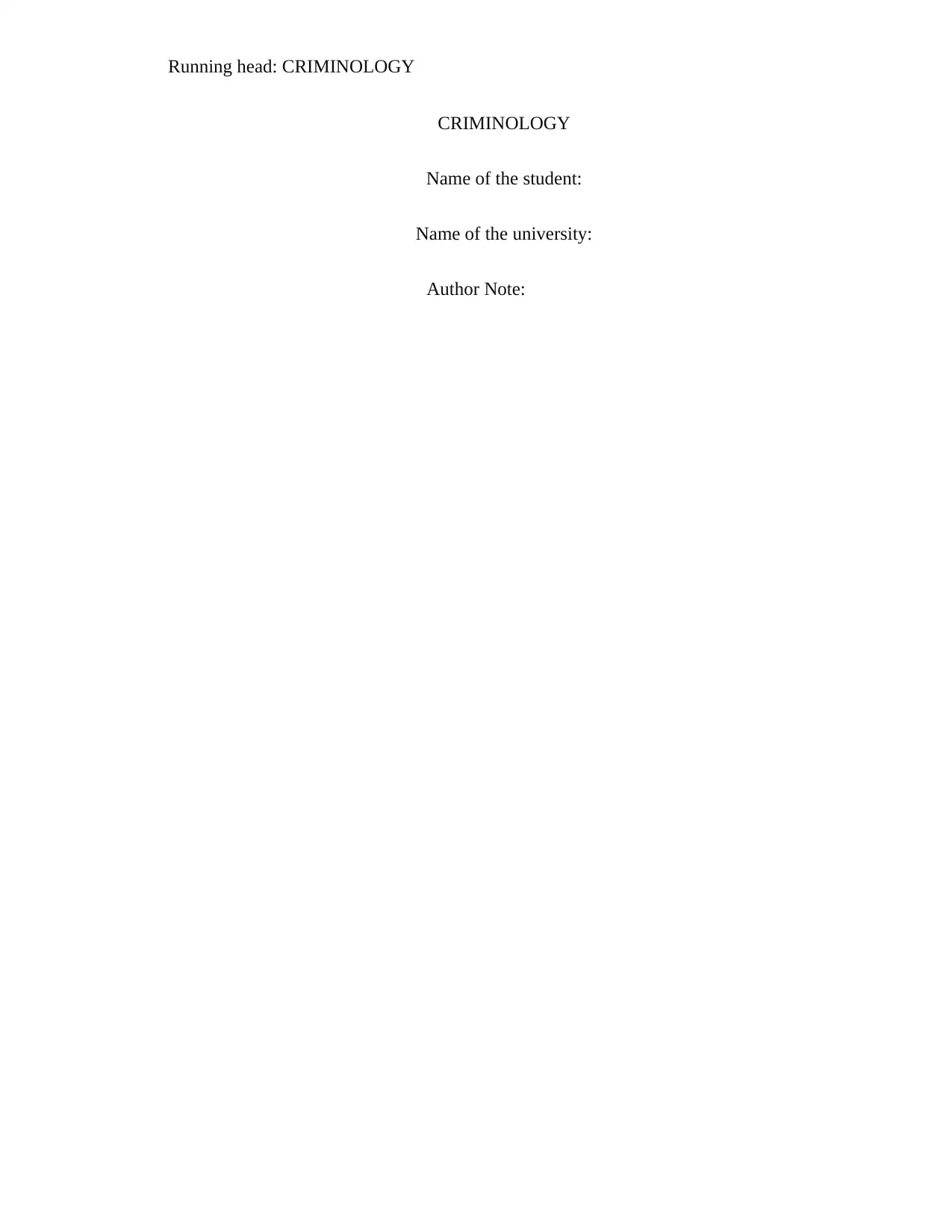
Running head: CRIMINOLOGY
CRIMINOLOGY
Name of the student:
Name of the university:
Author Note:
CRIMINOLOGY
Name of the student:
Name of the university:
Author Note:
Paraphrase This Document
Need a fresh take? Get an instant paraphrase of this document with our AI Paraphraser
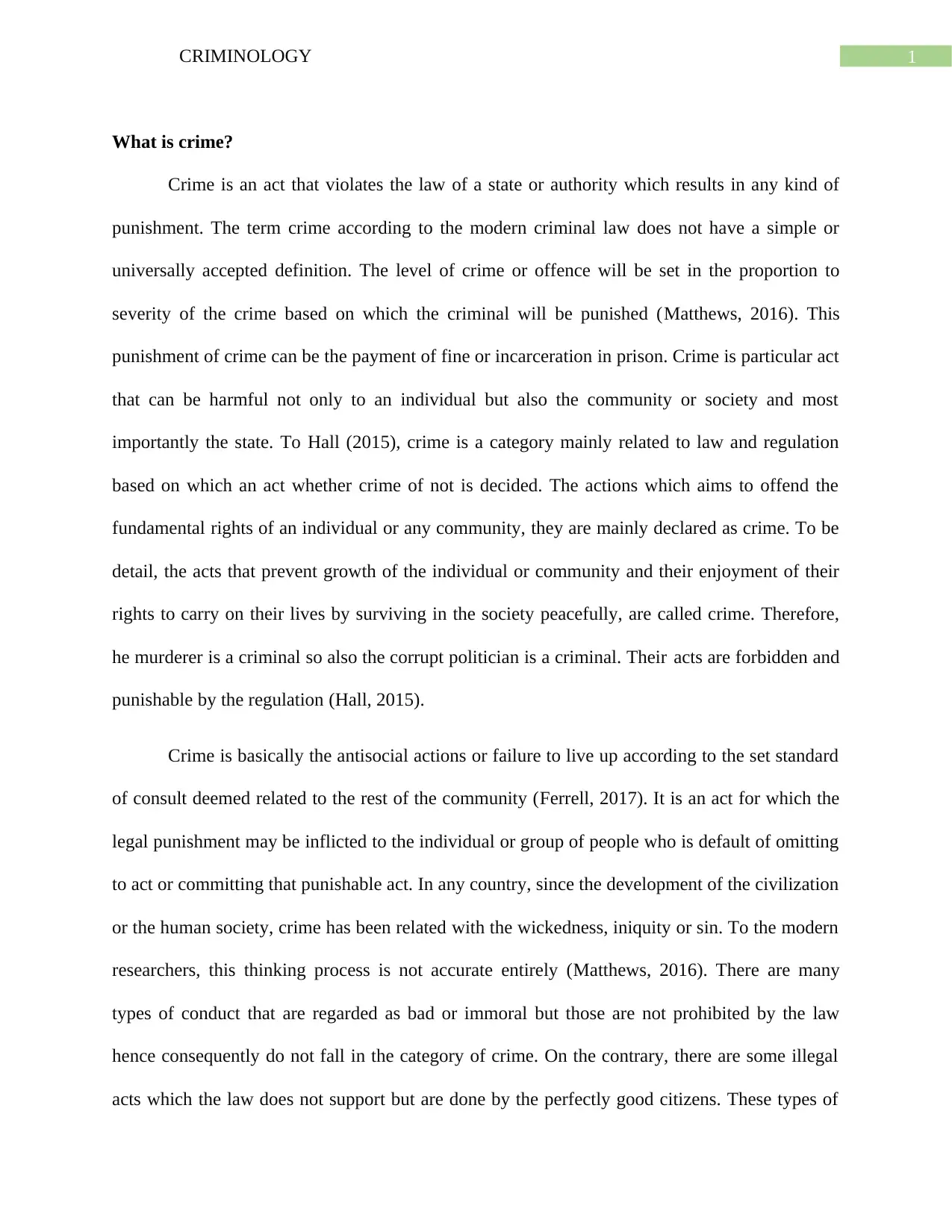
1CRIMINOLOGY
What is crime?
Crime is an act that violates the law of a state or authority which results in any kind of
punishment. The term crime according to the modern criminal law does not have a simple or
universally accepted definition. The level of crime or offence will be set in the proportion to
severity of the crime based on which the criminal will be punished (Matthews, 2016). This
punishment of crime can be the payment of fine or incarceration in prison. Crime is particular act
that can be harmful not only to an individual but also the community or society and most
importantly the state. To Hall (2015), crime is a category mainly related to law and regulation
based on which an act whether crime of not is decided. The actions which aims to offend the
fundamental rights of an individual or any community, they are mainly declared as crime. To be
detail, the acts that prevent growth of the individual or community and their enjoyment of their
rights to carry on their lives by surviving in the society peacefully, are called crime. Therefore,
he murderer is a criminal so also the corrupt politician is a criminal. Their acts are forbidden and
punishable by the regulation (Hall, 2015).
Crime is basically the antisocial actions or failure to live up according to the set standard
of consult deemed related to the rest of the community (Ferrell, 2017). It is an act for which the
legal punishment may be inflicted to the individual or group of people who is default of omitting
to act or committing that punishable act. In any country, since the development of the civilization
or the human society, crime has been related with the wickedness, iniquity or sin. To the modern
researchers, this thinking process is not accurate entirely (Matthews, 2016). There are many
types of conduct that are regarded as bad or immoral but those are not prohibited by the law
hence consequently do not fall in the category of crime. On the contrary, there are some illegal
acts which the law does not support but are done by the perfectly good citizens. These types of
What is crime?
Crime is an act that violates the law of a state or authority which results in any kind of
punishment. The term crime according to the modern criminal law does not have a simple or
universally accepted definition. The level of crime or offence will be set in the proportion to
severity of the crime based on which the criminal will be punished (Matthews, 2016). This
punishment of crime can be the payment of fine or incarceration in prison. Crime is particular act
that can be harmful not only to an individual but also the community or society and most
importantly the state. To Hall (2015), crime is a category mainly related to law and regulation
based on which an act whether crime of not is decided. The actions which aims to offend the
fundamental rights of an individual or any community, they are mainly declared as crime. To be
detail, the acts that prevent growth of the individual or community and their enjoyment of their
rights to carry on their lives by surviving in the society peacefully, are called crime. Therefore,
he murderer is a criminal so also the corrupt politician is a criminal. Their acts are forbidden and
punishable by the regulation (Hall, 2015).
Crime is basically the antisocial actions or failure to live up according to the set standard
of consult deemed related to the rest of the community (Ferrell, 2017). It is an act for which the
legal punishment may be inflicted to the individual or group of people who is default of omitting
to act or committing that punishable act. In any country, since the development of the civilization
or the human society, crime has been related with the wickedness, iniquity or sin. To the modern
researchers, this thinking process is not accurate entirely (Matthews, 2016). There are many
types of conduct that are regarded as bad or immoral but those are not prohibited by the law
hence consequently do not fall in the category of crime. On the contrary, there are some illegal
acts which the law does not support but are done by the perfectly good citizens. These types of
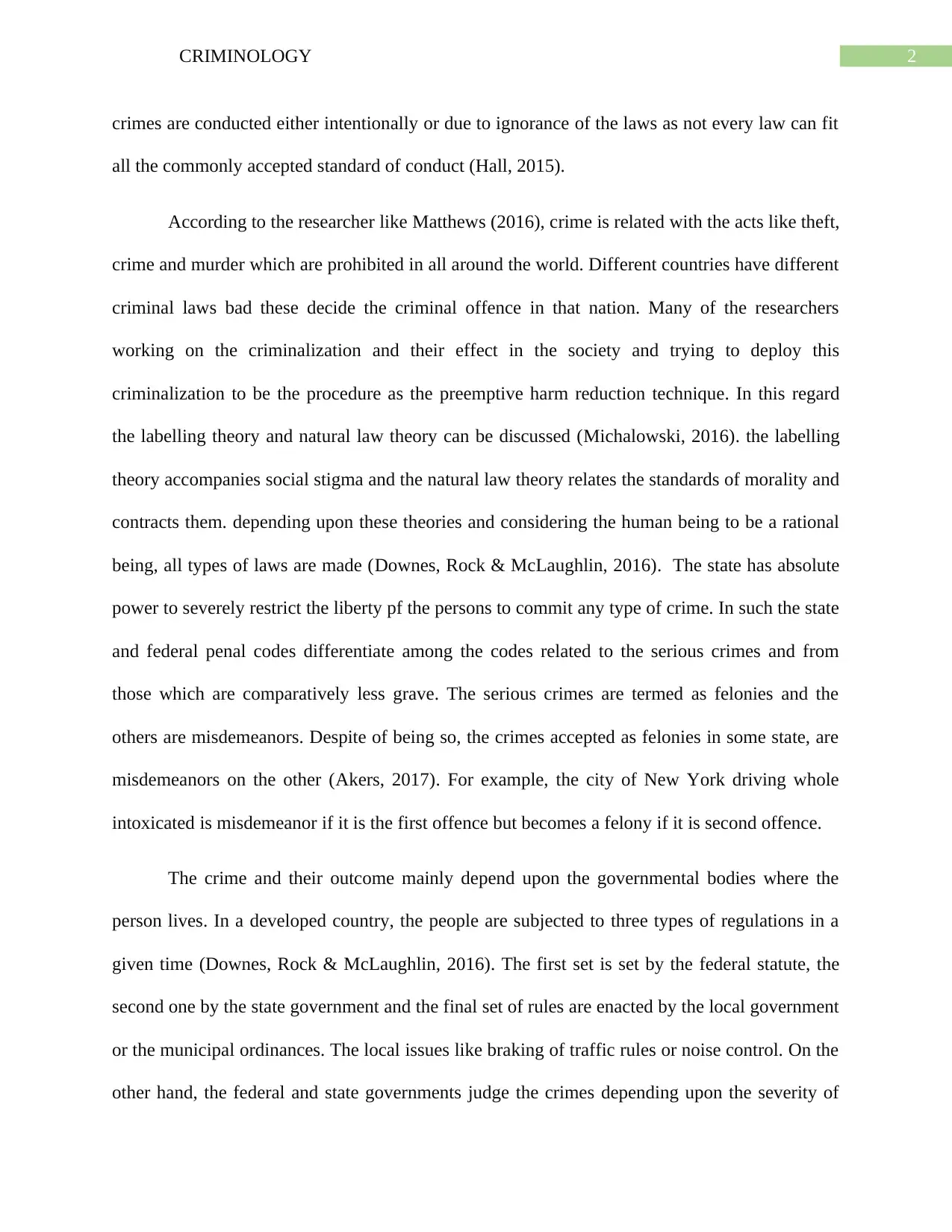
2CRIMINOLOGY
crimes are conducted either intentionally or due to ignorance of the laws as not every law can fit
all the commonly accepted standard of conduct (Hall, 2015).
According to the researcher like Matthews (2016), crime is related with the acts like theft,
crime and murder which are prohibited in all around the world. Different countries have different
criminal laws bad these decide the criminal offence in that nation. Many of the researchers
working on the criminalization and their effect in the society and trying to deploy this
criminalization to be the procedure as the preemptive harm reduction technique. In this regard
the labelling theory and natural law theory can be discussed (Michalowski, 2016). the labelling
theory accompanies social stigma and the natural law theory relates the standards of morality and
contracts them. depending upon these theories and considering the human being to be a rational
being, all types of laws are made (Downes, Rock & McLaughlin, 2016). The state has absolute
power to severely restrict the liberty pf the persons to commit any type of crime. In such the state
and federal penal codes differentiate among the codes related to the serious crimes and from
those which are comparatively less grave. The serious crimes are termed as felonies and the
others are misdemeanors. Despite of being so, the crimes accepted as felonies in some state, are
misdemeanors on the other (Akers, 2017). For example, the city of New York driving whole
intoxicated is misdemeanor if it is the first offence but becomes a felony if it is second offence.
The crime and their outcome mainly depend upon the governmental bodies where the
person lives. In a developed country, the people are subjected to three types of regulations in a
given time (Downes, Rock & McLaughlin, 2016). The first set is set by the federal statute, the
second one by the state government and the final set of rules are enacted by the local government
or the municipal ordinances. The local issues like braking of traffic rules or noise control. On the
other hand, the federal and state governments judge the crimes depending upon the severity of
crimes are conducted either intentionally or due to ignorance of the laws as not every law can fit
all the commonly accepted standard of conduct (Hall, 2015).
According to the researcher like Matthews (2016), crime is related with the acts like theft,
crime and murder which are prohibited in all around the world. Different countries have different
criminal laws bad these decide the criminal offence in that nation. Many of the researchers
working on the criminalization and their effect in the society and trying to deploy this
criminalization to be the procedure as the preemptive harm reduction technique. In this regard
the labelling theory and natural law theory can be discussed (Michalowski, 2016). the labelling
theory accompanies social stigma and the natural law theory relates the standards of morality and
contracts them. depending upon these theories and considering the human being to be a rational
being, all types of laws are made (Downes, Rock & McLaughlin, 2016). The state has absolute
power to severely restrict the liberty pf the persons to commit any type of crime. In such the state
and federal penal codes differentiate among the codes related to the serious crimes and from
those which are comparatively less grave. The serious crimes are termed as felonies and the
others are misdemeanors. Despite of being so, the crimes accepted as felonies in some state, are
misdemeanors on the other (Akers, 2017). For example, the city of New York driving whole
intoxicated is misdemeanor if it is the first offence but becomes a felony if it is second offence.
The crime and their outcome mainly depend upon the governmental bodies where the
person lives. In a developed country, the people are subjected to three types of regulations in a
given time (Downes, Rock & McLaughlin, 2016). The first set is set by the federal statute, the
second one by the state government and the final set of rules are enacted by the local government
or the municipal ordinances. The local issues like braking of traffic rules or noise control. On the
other hand, the federal and state governments judge the crimes depending upon the severity of
⊘ This is a preview!⊘
Do you want full access?
Subscribe today to unlock all pages.

Trusted by 1+ million students worldwide
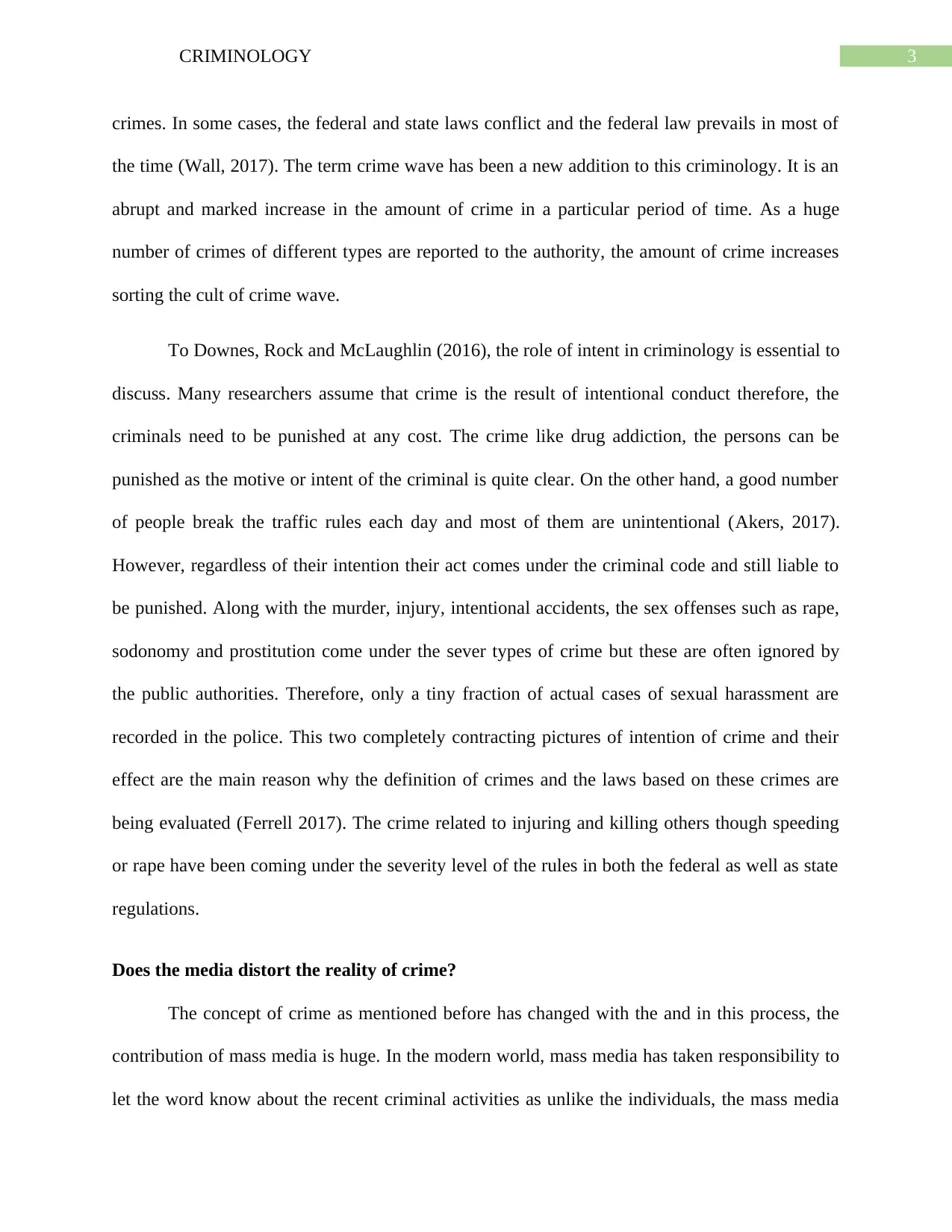
3CRIMINOLOGY
crimes. In some cases, the federal and state laws conflict and the federal law prevails in most of
the time (Wall, 2017). The term crime wave has been a new addition to this criminology. It is an
abrupt and marked increase in the amount of crime in a particular period of time. As a huge
number of crimes of different types are reported to the authority, the amount of crime increases
sorting the cult of crime wave.
To Downes, Rock and McLaughlin (2016), the role of intent in criminology is essential to
discuss. Many researchers assume that crime is the result of intentional conduct therefore, the
criminals need to be punished at any cost. The crime like drug addiction, the persons can be
punished as the motive or intent of the criminal is quite clear. On the other hand, a good number
of people break the traffic rules each day and most of them are unintentional (Akers, 2017).
However, regardless of their intention their act comes under the criminal code and still liable to
be punished. Along with the murder, injury, intentional accidents, the sex offenses such as rape,
sodonomy and prostitution come under the sever types of crime but these are often ignored by
the public authorities. Therefore, only a tiny fraction of actual cases of sexual harassment are
recorded in the police. This two completely contracting pictures of intention of crime and their
effect are the main reason why the definition of crimes and the laws based on these crimes are
being evaluated (Ferrell 2017). The crime related to injuring and killing others though speeding
or rape have been coming under the severity level of the rules in both the federal as well as state
regulations.
Does the media distort the reality of crime?
The concept of crime as mentioned before has changed with the and in this process, the
contribution of mass media is huge. In the modern world, mass media has taken responsibility to
let the word know about the recent criminal activities as unlike the individuals, the mass media
crimes. In some cases, the federal and state laws conflict and the federal law prevails in most of
the time (Wall, 2017). The term crime wave has been a new addition to this criminology. It is an
abrupt and marked increase in the amount of crime in a particular period of time. As a huge
number of crimes of different types are reported to the authority, the amount of crime increases
sorting the cult of crime wave.
To Downes, Rock and McLaughlin (2016), the role of intent in criminology is essential to
discuss. Many researchers assume that crime is the result of intentional conduct therefore, the
criminals need to be punished at any cost. The crime like drug addiction, the persons can be
punished as the motive or intent of the criminal is quite clear. On the other hand, a good number
of people break the traffic rules each day and most of them are unintentional (Akers, 2017).
However, regardless of their intention their act comes under the criminal code and still liable to
be punished. Along with the murder, injury, intentional accidents, the sex offenses such as rape,
sodonomy and prostitution come under the sever types of crime but these are often ignored by
the public authorities. Therefore, only a tiny fraction of actual cases of sexual harassment are
recorded in the police. This two completely contracting pictures of intention of crime and their
effect are the main reason why the definition of crimes and the laws based on these crimes are
being evaluated (Ferrell 2017). The crime related to injuring and killing others though speeding
or rape have been coming under the severity level of the rules in both the federal as well as state
regulations.
Does the media distort the reality of crime?
The concept of crime as mentioned before has changed with the and in this process, the
contribution of mass media is huge. In the modern world, mass media has taken responsibility to
let the word know about the recent criminal activities as unlike the individuals, the mass media
Paraphrase This Document
Need a fresh take? Get an instant paraphrase of this document with our AI Paraphraser
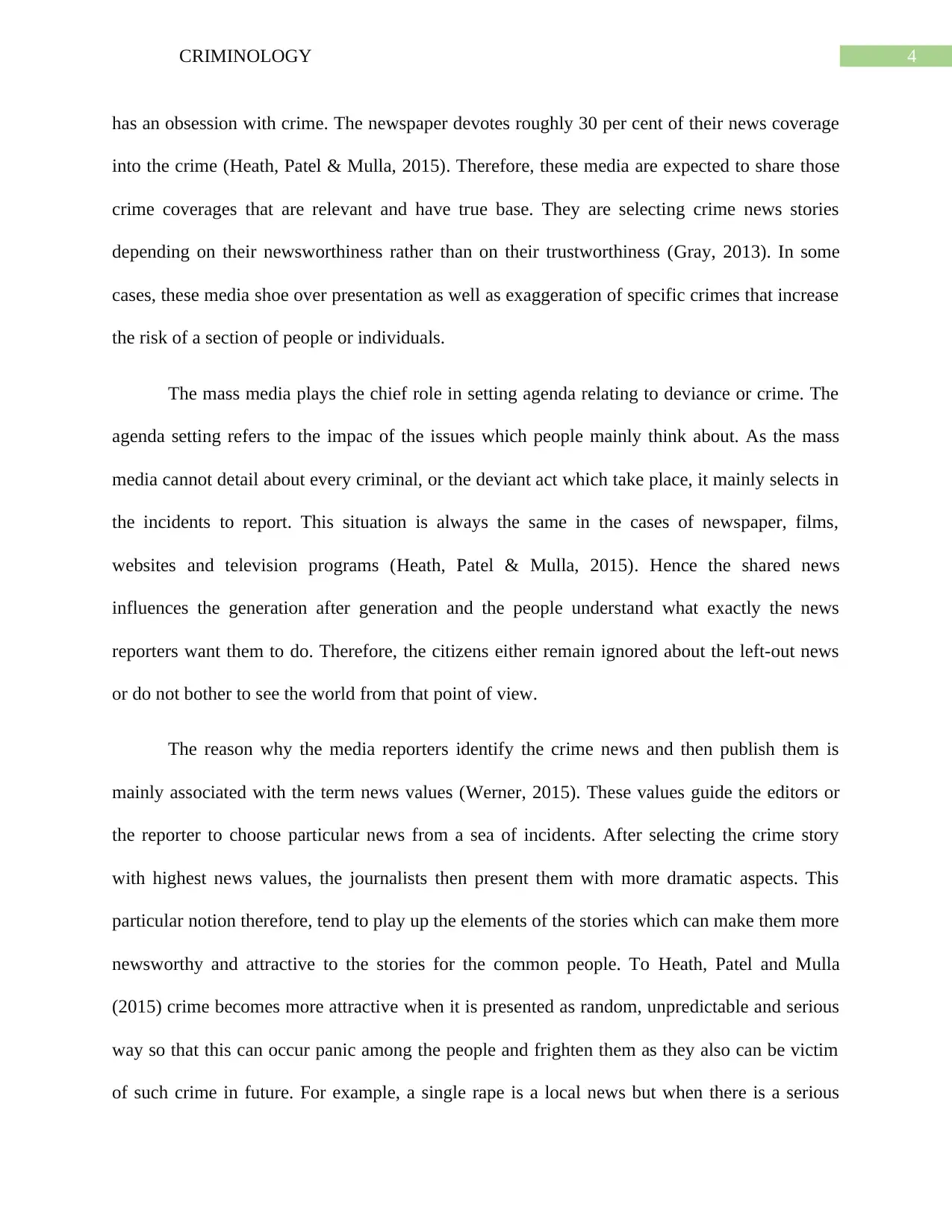
4CRIMINOLOGY
has an obsession with crime. The newspaper devotes roughly 30 per cent of their news coverage
into the crime (Heath, Patel & Mulla, 2015). Therefore, these media are expected to share those
crime coverages that are relevant and have true base. They are selecting crime news stories
depending on their newsworthiness rather than on their trustworthiness (Gray, 2013). In some
cases, these media shoe over presentation as well as exaggeration of specific crimes that increase
the risk of a section of people or individuals.
The mass media plays the chief role in setting agenda relating to deviance or crime. The
agenda setting refers to the impac of the issues which people mainly think about. As the mass
media cannot detail about every criminal, or the deviant act which take place, it mainly selects in
the incidents to report. This situation is always the same in the cases of newspaper, films,
websites and television programs (Heath, Patel & Mulla, 2015). Hence the shared news
influences the generation after generation and the people understand what exactly the news
reporters want them to do. Therefore, the citizens either remain ignored about the left-out news
or do not bother to see the world from that point of view.
The reason why the media reporters identify the crime news and then publish them is
mainly associated with the term news values (Werner, 2015). These values guide the editors or
the reporter to choose particular news from a sea of incidents. After selecting the crime story
with highest news values, the journalists then present them with more dramatic aspects. This
particular notion therefore, tend to play up the elements of the stories which can make them more
newsworthy and attractive to the stories for the common people. To Heath, Patel and Mulla
(2015) crime becomes more attractive when it is presented as random, unpredictable and serious
way so that this can occur panic among the people and frighten them as they also can be victim
of such crime in future. For example, a single rape is a local news but when there is a serious
has an obsession with crime. The newspaper devotes roughly 30 per cent of their news coverage
into the crime (Heath, Patel & Mulla, 2015). Therefore, these media are expected to share those
crime coverages that are relevant and have true base. They are selecting crime news stories
depending on their newsworthiness rather than on their trustworthiness (Gray, 2013). In some
cases, these media shoe over presentation as well as exaggeration of specific crimes that increase
the risk of a section of people or individuals.
The mass media plays the chief role in setting agenda relating to deviance or crime. The
agenda setting refers to the impac of the issues which people mainly think about. As the mass
media cannot detail about every criminal, or the deviant act which take place, it mainly selects in
the incidents to report. This situation is always the same in the cases of newspaper, films,
websites and television programs (Heath, Patel & Mulla, 2015). Hence the shared news
influences the generation after generation and the people understand what exactly the news
reporters want them to do. Therefore, the citizens either remain ignored about the left-out news
or do not bother to see the world from that point of view.
The reason why the media reporters identify the crime news and then publish them is
mainly associated with the term news values (Werner, 2015). These values guide the editors or
the reporter to choose particular news from a sea of incidents. After selecting the crime story
with highest news values, the journalists then present them with more dramatic aspects. This
particular notion therefore, tend to play up the elements of the stories which can make them more
newsworthy and attractive to the stories for the common people. To Heath, Patel and Mulla
(2015) crime becomes more attractive when it is presented as random, unpredictable and serious
way so that this can occur panic among the people and frighten them as they also can be victim
of such crime in future. For example, a single rape is a local news but when there is a serious
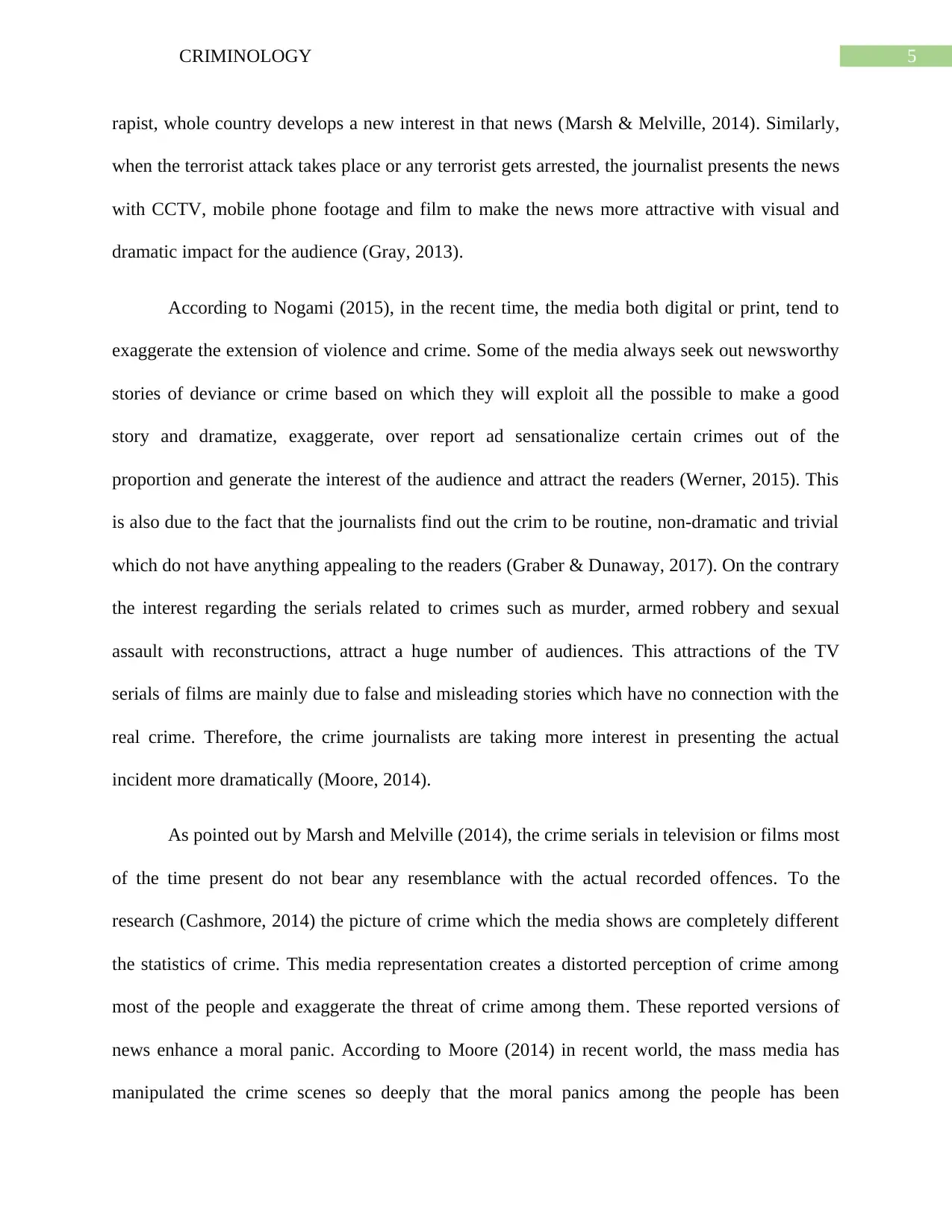
5CRIMINOLOGY
rapist, whole country develops a new interest in that news (Marsh & Melville, 2014). Similarly,
when the terrorist attack takes place or any terrorist gets arrested, the journalist presents the news
with CCTV, mobile phone footage and film to make the news more attractive with visual and
dramatic impact for the audience (Gray, 2013).
According to Nogami (2015), in the recent time, the media both digital or print, tend to
exaggerate the extension of violence and crime. Some of the media always seek out newsworthy
stories of deviance or crime based on which they will exploit all the possible to make a good
story and dramatize, exaggerate, over report ad sensationalize certain crimes out of the
proportion and generate the interest of the audience and attract the readers (Werner, 2015). This
is also due to the fact that the journalists find out the crim to be routine, non-dramatic and trivial
which do not have anything appealing to the readers (Graber & Dunaway, 2017). On the contrary
the interest regarding the serials related to crimes such as murder, armed robbery and sexual
assault with reconstructions, attract a huge number of audiences. This attractions of the TV
serials of films are mainly due to false and misleading stories which have no connection with the
real crime. Therefore, the crime journalists are taking more interest in presenting the actual
incident more dramatically (Moore, 2014).
As pointed out by Marsh and Melville (2014), the crime serials in television or films most
of the time present do not bear any resemblance with the actual recorded offences. To the
research (Cashmore, 2014) the picture of crime which the media shows are completely different
the statistics of crime. This media representation creates a distorted perception of crime among
most of the people and exaggerate the threat of crime among them. These reported versions of
news enhance a moral panic. According to Moore (2014) in recent world, the mass media has
manipulated the crime scenes so deeply that the moral panics among the people has been
rapist, whole country develops a new interest in that news (Marsh & Melville, 2014). Similarly,
when the terrorist attack takes place or any terrorist gets arrested, the journalist presents the news
with CCTV, mobile phone footage and film to make the news more attractive with visual and
dramatic impact for the audience (Gray, 2013).
According to Nogami (2015), in the recent time, the media both digital or print, tend to
exaggerate the extension of violence and crime. Some of the media always seek out newsworthy
stories of deviance or crime based on which they will exploit all the possible to make a good
story and dramatize, exaggerate, over report ad sensationalize certain crimes out of the
proportion and generate the interest of the audience and attract the readers (Werner, 2015). This
is also due to the fact that the journalists find out the crim to be routine, non-dramatic and trivial
which do not have anything appealing to the readers (Graber & Dunaway, 2017). On the contrary
the interest regarding the serials related to crimes such as murder, armed robbery and sexual
assault with reconstructions, attract a huge number of audiences. This attractions of the TV
serials of films are mainly due to false and misleading stories which have no connection with the
real crime. Therefore, the crime journalists are taking more interest in presenting the actual
incident more dramatically (Moore, 2014).
As pointed out by Marsh and Melville (2014), the crime serials in television or films most
of the time present do not bear any resemblance with the actual recorded offences. To the
research (Cashmore, 2014) the picture of crime which the media shows are completely different
the statistics of crime. This media representation creates a distorted perception of crime among
most of the people and exaggerate the threat of crime among them. These reported versions of
news enhance a moral panic. According to Moore (2014) in recent world, the mass media has
manipulated the crime scenes so deeply that the moral panics among the people has been
⊘ This is a preview!⊘
Do you want full access?
Subscribe today to unlock all pages.

Trusted by 1+ million students worldwide
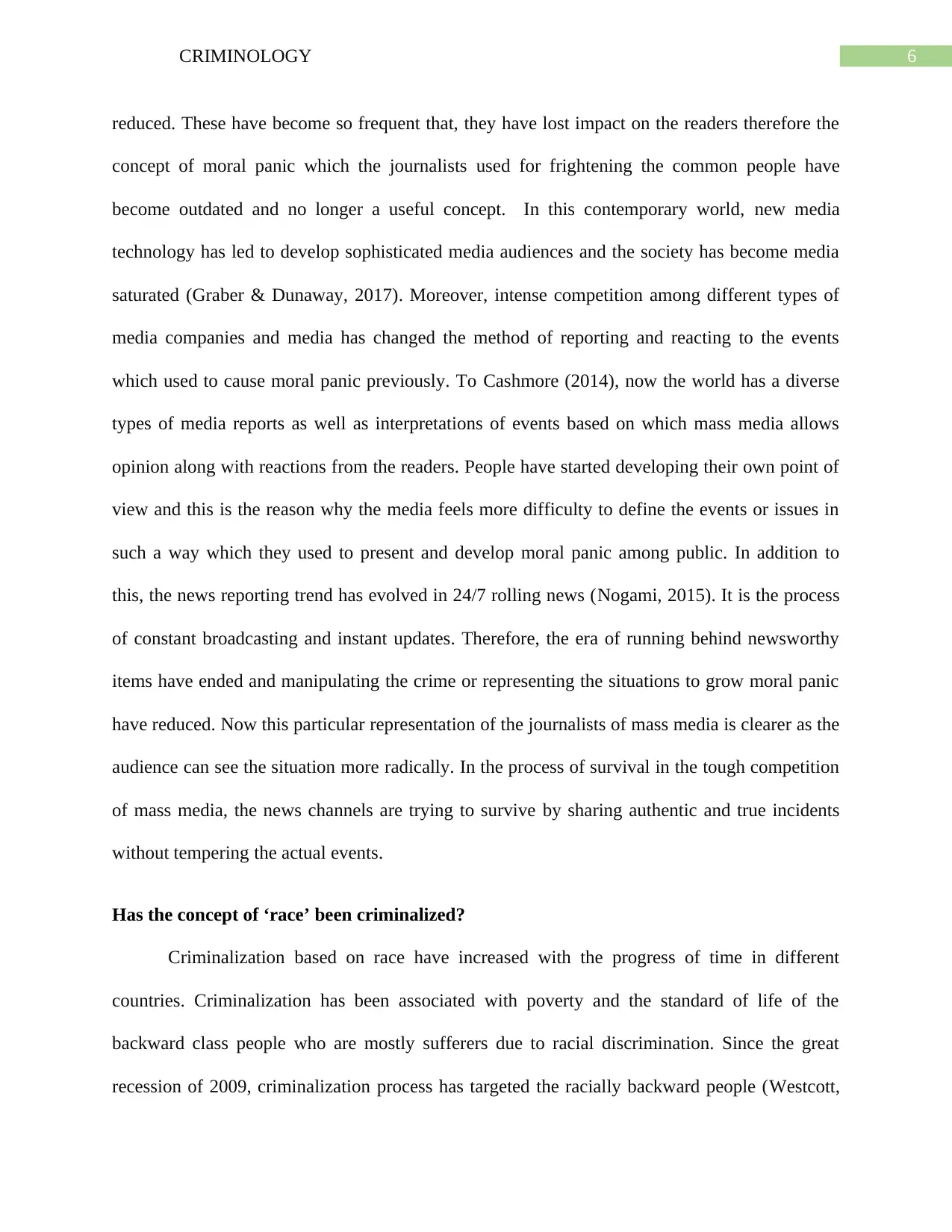
6CRIMINOLOGY
reduced. These have become so frequent that, they have lost impact on the readers therefore the
concept of moral panic which the journalists used for frightening the common people have
become outdated and no longer a useful concept. In this contemporary world, new media
technology has led to develop sophisticated media audiences and the society has become media
saturated (Graber & Dunaway, 2017). Moreover, intense competition among different types of
media companies and media has changed the method of reporting and reacting to the events
which used to cause moral panic previously. To Cashmore (2014), now the world has a diverse
types of media reports as well as interpretations of events based on which mass media allows
opinion along with reactions from the readers. People have started developing their own point of
view and this is the reason why the media feels more difficulty to define the events or issues in
such a way which they used to present and develop moral panic among public. In addition to
this, the news reporting trend has evolved in 24/7 rolling news (Nogami, 2015). It is the process
of constant broadcasting and instant updates. Therefore, the era of running behind newsworthy
items have ended and manipulating the crime or representing the situations to grow moral panic
have reduced. Now this particular representation of the journalists of mass media is clearer as the
audience can see the situation more radically. In the process of survival in the tough competition
of mass media, the news channels are trying to survive by sharing authentic and true incidents
without tempering the actual events.
Has the concept of ‘race’ been criminalized?
Criminalization based on race have increased with the progress of time in different
countries. Criminalization has been associated with poverty and the standard of life of the
backward class people who are mostly sufferers due to racial discrimination. Since the great
recession of 2009, criminalization process has targeted the racially backward people (Westcott,
reduced. These have become so frequent that, they have lost impact on the readers therefore the
concept of moral panic which the journalists used for frightening the common people have
become outdated and no longer a useful concept. In this contemporary world, new media
technology has led to develop sophisticated media audiences and the society has become media
saturated (Graber & Dunaway, 2017). Moreover, intense competition among different types of
media companies and media has changed the method of reporting and reacting to the events
which used to cause moral panic previously. To Cashmore (2014), now the world has a diverse
types of media reports as well as interpretations of events based on which mass media allows
opinion along with reactions from the readers. People have started developing their own point of
view and this is the reason why the media feels more difficulty to define the events or issues in
such a way which they used to present and develop moral panic among public. In addition to
this, the news reporting trend has evolved in 24/7 rolling news (Nogami, 2015). It is the process
of constant broadcasting and instant updates. Therefore, the era of running behind newsworthy
items have ended and manipulating the crime or representing the situations to grow moral panic
have reduced. Now this particular representation of the journalists of mass media is clearer as the
audience can see the situation more radically. In the process of survival in the tough competition
of mass media, the news channels are trying to survive by sharing authentic and true incidents
without tempering the actual events.
Has the concept of ‘race’ been criminalized?
Criminalization based on race have increased with the progress of time in different
countries. Criminalization has been associated with poverty and the standard of life of the
backward class people who are mostly sufferers due to racial discrimination. Since the great
recession of 2009, criminalization process has targeted the racially backward people (Westcott,
Paraphrase This Document
Need a fresh take? Get an instant paraphrase of this document with our AI Paraphraser
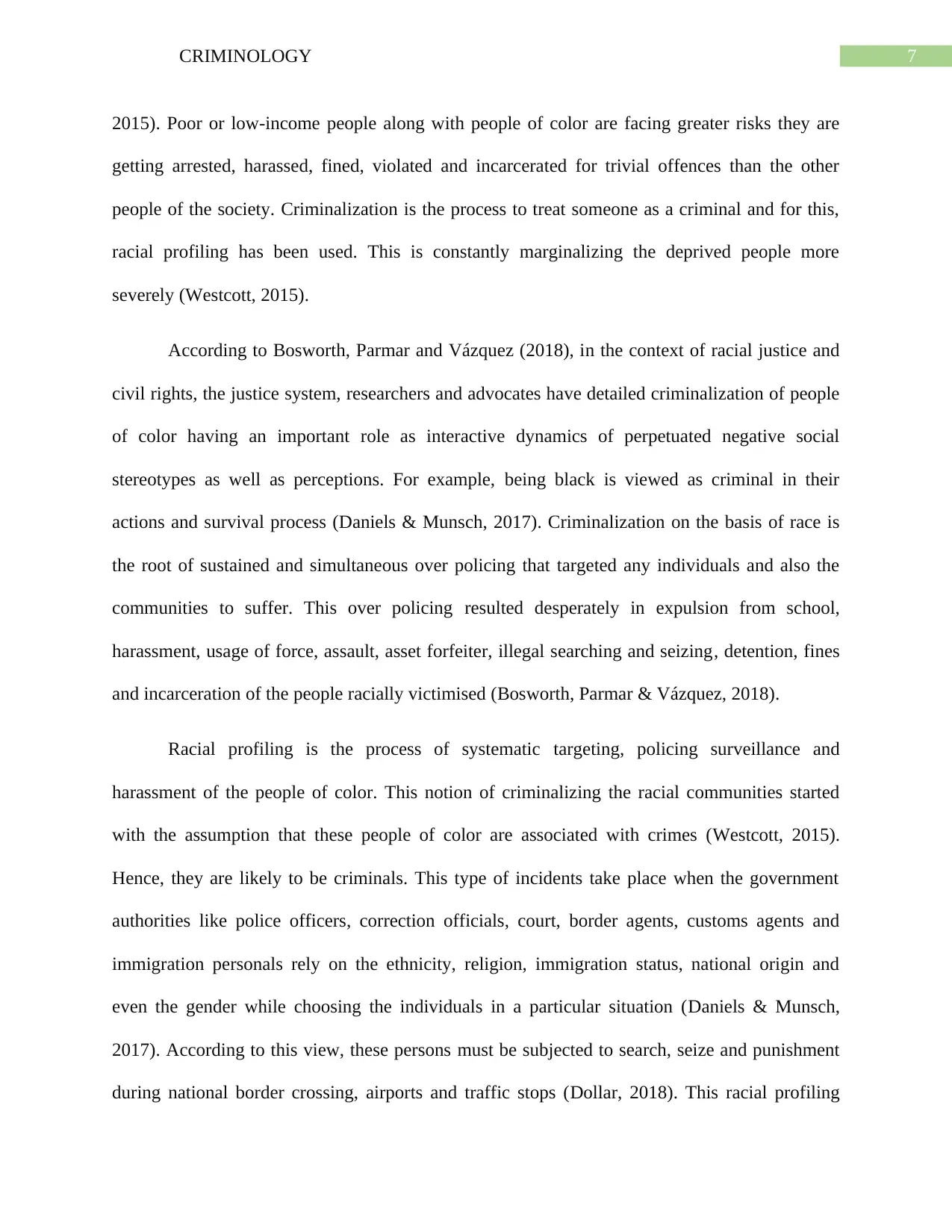
7CRIMINOLOGY
2015). Poor or low-income people along with people of color are facing greater risks they are
getting arrested, harassed, fined, violated and incarcerated for trivial offences than the other
people of the society. Criminalization is the process to treat someone as a criminal and for this,
racial profiling has been used. This is constantly marginalizing the deprived people more
severely (Westcott, 2015).
According to Bosworth, Parmar and Vázquez (2018), in the context of racial justice and
civil rights, the justice system, researchers and advocates have detailed criminalization of people
of color having an important role as interactive dynamics of perpetuated negative social
stereotypes as well as perceptions. For example, being black is viewed as criminal in their
actions and survival process (Daniels & Munsch, 2017). Criminalization on the basis of race is
the root of sustained and simultaneous over policing that targeted any individuals and also the
communities to suffer. This over policing resulted desperately in expulsion from school,
harassment, usage of force, assault, asset forfeiter, illegal searching and seizing, detention, fines
and incarceration of the people racially victimised (Bosworth, Parmar & Vázquez, 2018).
Racial profiling is the process of systematic targeting, policing surveillance and
harassment of the people of color. This notion of criminalizing the racial communities started
with the assumption that these people of color are associated with crimes (Westcott, 2015).
Hence, they are likely to be criminals. This type of incidents take place when the government
authorities like police officers, correction officials, court, border agents, customs agents and
immigration personals rely on the ethnicity, religion, immigration status, national origin and
even the gender while choosing the individuals in a particular situation (Daniels & Munsch,
2017). According to this view, these persons must be subjected to search, seize and punishment
during national border crossing, airports and traffic stops (Dollar, 2018). This racial profiling
2015). Poor or low-income people along with people of color are facing greater risks they are
getting arrested, harassed, fined, violated and incarcerated for trivial offences than the other
people of the society. Criminalization is the process to treat someone as a criminal and for this,
racial profiling has been used. This is constantly marginalizing the deprived people more
severely (Westcott, 2015).
According to Bosworth, Parmar and Vázquez (2018), in the context of racial justice and
civil rights, the justice system, researchers and advocates have detailed criminalization of people
of color having an important role as interactive dynamics of perpetuated negative social
stereotypes as well as perceptions. For example, being black is viewed as criminal in their
actions and survival process (Daniels & Munsch, 2017). Criminalization on the basis of race is
the root of sustained and simultaneous over policing that targeted any individuals and also the
communities to suffer. This over policing resulted desperately in expulsion from school,
harassment, usage of force, assault, asset forfeiter, illegal searching and seizing, detention, fines
and incarceration of the people racially victimised (Bosworth, Parmar & Vázquez, 2018).
Racial profiling is the process of systematic targeting, policing surveillance and
harassment of the people of color. This notion of criminalizing the racial communities started
with the assumption that these people of color are associated with crimes (Westcott, 2015).
Hence, they are likely to be criminals. This type of incidents take place when the government
authorities like police officers, correction officials, court, border agents, customs agents and
immigration personals rely on the ethnicity, religion, immigration status, national origin and
even the gender while choosing the individuals in a particular situation (Daniels & Munsch,
2017). According to this view, these persons must be subjected to search, seize and punishment
during national border crossing, airports and traffic stops (Dollar, 2018). This racial profiling
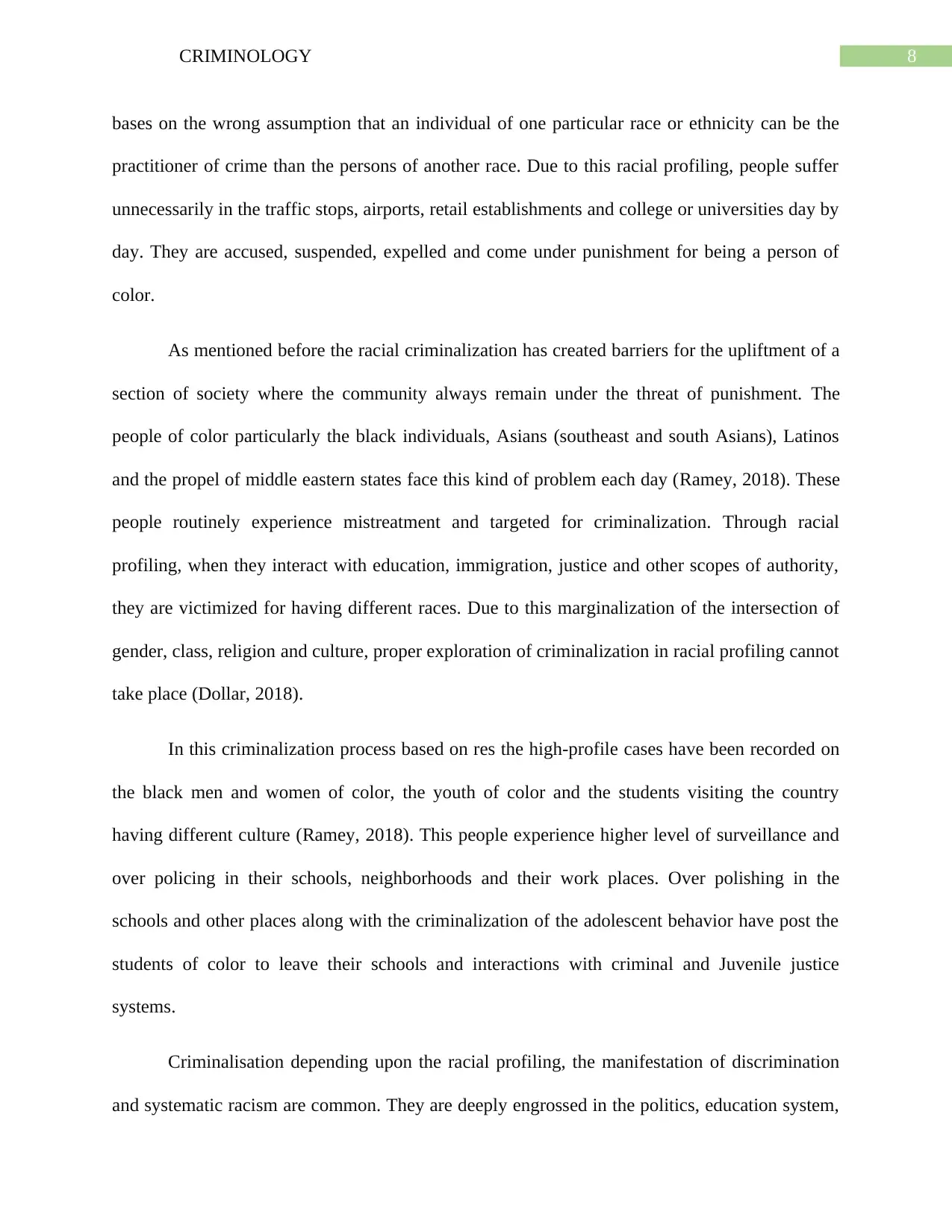
8CRIMINOLOGY
bases on the wrong assumption that an individual of one particular race or ethnicity can be the
practitioner of crime than the persons of another race. Due to this racial profiling, people suffer
unnecessarily in the traffic stops, airports, retail establishments and college or universities day by
day. They are accused, suspended, expelled and come under punishment for being a person of
color.
As mentioned before the racial criminalization has created barriers for the upliftment of a
section of society where the community always remain under the threat of punishment. The
people of color particularly the black individuals, Asians (southeast and south Asians), Latinos
and the propel of middle eastern states face this kind of problem each day (Ramey, 2018). These
people routinely experience mistreatment and targeted for criminalization. Through racial
profiling, when they interact with education, immigration, justice and other scopes of authority,
they are victimized for having different races. Due to this marginalization of the intersection of
gender, class, religion and culture, proper exploration of criminalization in racial profiling cannot
take place (Dollar, 2018).
In this criminalization process based on res the high-profile cases have been recorded on
the black men and women of color, the youth of color and the students visiting the country
having different culture (Ramey, 2018). This people experience higher level of surveillance and
over policing in their schools, neighborhoods and their work places. Over polishing in the
schools and other places along with the criminalization of the adolescent behavior have post the
students of color to leave their schools and interactions with criminal and Juvenile justice
systems.
Criminalisation depending upon the racial profiling, the manifestation of discrimination
and systematic racism are common. They are deeply engrossed in the politics, education system,
bases on the wrong assumption that an individual of one particular race or ethnicity can be the
practitioner of crime than the persons of another race. Due to this racial profiling, people suffer
unnecessarily in the traffic stops, airports, retail establishments and college or universities day by
day. They are accused, suspended, expelled and come under punishment for being a person of
color.
As mentioned before the racial criminalization has created barriers for the upliftment of a
section of society where the community always remain under the threat of punishment. The
people of color particularly the black individuals, Asians (southeast and south Asians), Latinos
and the propel of middle eastern states face this kind of problem each day (Ramey, 2018). These
people routinely experience mistreatment and targeted for criminalization. Through racial
profiling, when they interact with education, immigration, justice and other scopes of authority,
they are victimized for having different races. Due to this marginalization of the intersection of
gender, class, religion and culture, proper exploration of criminalization in racial profiling cannot
take place (Dollar, 2018).
In this criminalization process based on res the high-profile cases have been recorded on
the black men and women of color, the youth of color and the students visiting the country
having different culture (Ramey, 2018). This people experience higher level of surveillance and
over policing in their schools, neighborhoods and their work places. Over polishing in the
schools and other places along with the criminalization of the adolescent behavior have post the
students of color to leave their schools and interactions with criminal and Juvenile justice
systems.
Criminalisation depending upon the racial profiling, the manifestation of discrimination
and systematic racism are common. They are deeply engrossed in the politics, education system,
⊘ This is a preview!⊘
Do you want full access?
Subscribe today to unlock all pages.

Trusted by 1+ million students worldwide
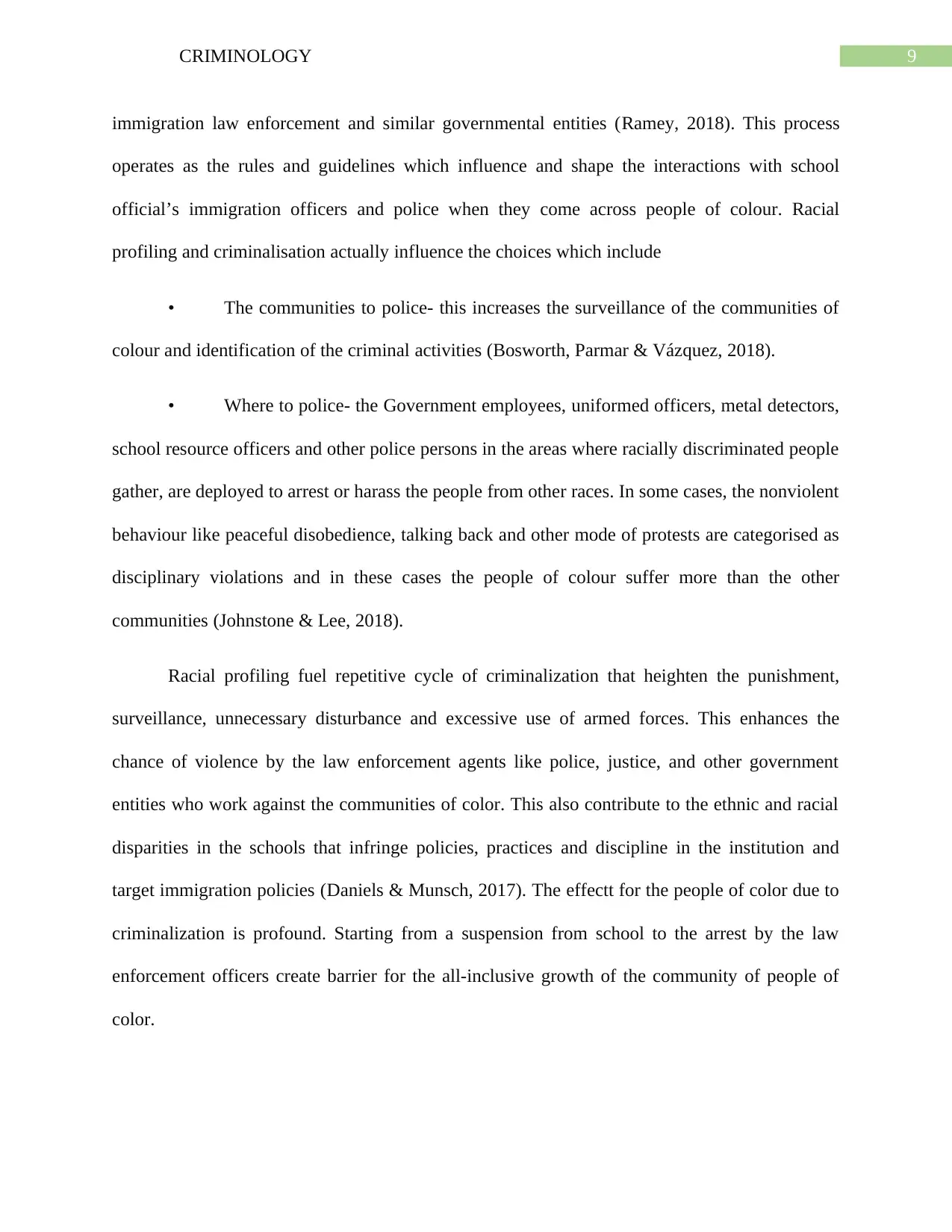
9CRIMINOLOGY
immigration law enforcement and similar governmental entities (Ramey, 2018). This process
operates as the rules and guidelines which influence and shape the interactions with school
official’s immigration officers and police when they come across people of colour. Racial
profiling and criminalisation actually influence the choices which include
• The communities to police- this increases the surveillance of the communities of
colour and identification of the criminal activities (Bosworth, Parmar & Vázquez, 2018).
• Where to police- the Government employees, uniformed officers, metal detectors,
school resource officers and other police persons in the areas where racially discriminated people
gather, are deployed to arrest or harass the people from other races. In some cases, the nonviolent
behaviour like peaceful disobedience, talking back and other mode of protests are categorised as
disciplinary violations and in these cases the people of colour suffer more than the other
communities (Johnstone & Lee, 2018).
Racial profiling fuel repetitive cycle of criminalization that heighten the punishment,
surveillance, unnecessary disturbance and excessive use of armed forces. This enhances the
chance of violence by the law enforcement agents like police, justice, and other government
entities who work against the communities of color. This also contribute to the ethnic and racial
disparities in the schools that infringe policies, practices and discipline in the institution and
target immigration policies (Daniels & Munsch, 2017). The effectt for the people of color due to
criminalization is profound. Starting from a suspension from school to the arrest by the law
enforcement officers create barrier for the all-inclusive growth of the community of people of
color.
immigration law enforcement and similar governmental entities (Ramey, 2018). This process
operates as the rules and guidelines which influence and shape the interactions with school
official’s immigration officers and police when they come across people of colour. Racial
profiling and criminalisation actually influence the choices which include
• The communities to police- this increases the surveillance of the communities of
colour and identification of the criminal activities (Bosworth, Parmar & Vázquez, 2018).
• Where to police- the Government employees, uniformed officers, metal detectors,
school resource officers and other police persons in the areas where racially discriminated people
gather, are deployed to arrest or harass the people from other races. In some cases, the nonviolent
behaviour like peaceful disobedience, talking back and other mode of protests are categorised as
disciplinary violations and in these cases the people of colour suffer more than the other
communities (Johnstone & Lee, 2018).
Racial profiling fuel repetitive cycle of criminalization that heighten the punishment,
surveillance, unnecessary disturbance and excessive use of armed forces. This enhances the
chance of violence by the law enforcement agents like police, justice, and other government
entities who work against the communities of color. This also contribute to the ethnic and racial
disparities in the schools that infringe policies, practices and discipline in the institution and
target immigration policies (Daniels & Munsch, 2017). The effectt for the people of color due to
criminalization is profound. Starting from a suspension from school to the arrest by the law
enforcement officers create barrier for the all-inclusive growth of the community of people of
color.
Paraphrase This Document
Need a fresh take? Get an instant paraphrase of this document with our AI Paraphraser
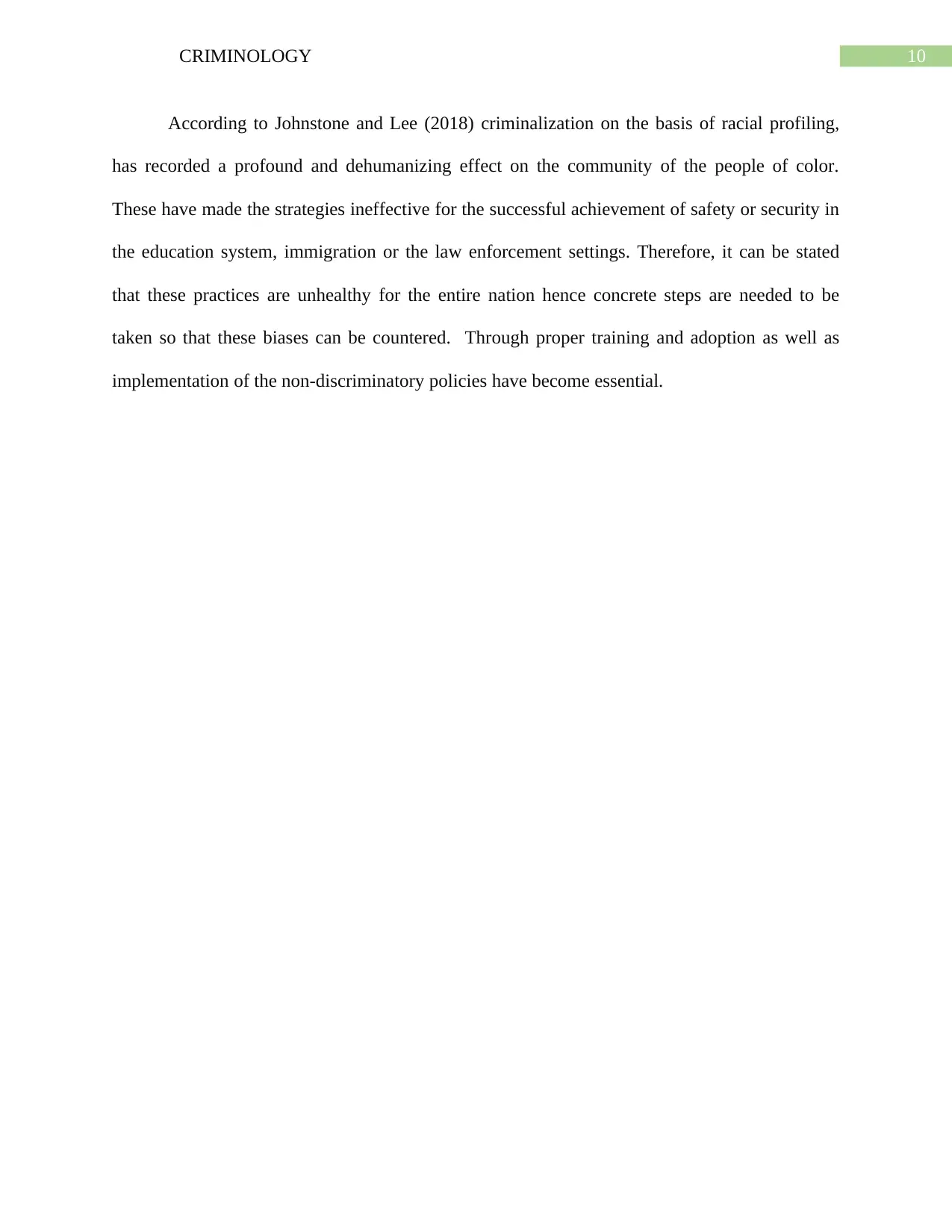
10CRIMINOLOGY
According to Johnstone and Lee (2018) criminalization on the basis of racial profiling,
has recorded a profound and dehumanizing effect on the community of the people of color.
These have made the strategies ineffective for the successful achievement of safety or security in
the education system, immigration or the law enforcement settings. Therefore, it can be stated
that these practices are unhealthy for the entire nation hence concrete steps are needed to be
taken so that these biases can be countered. Through proper training and adoption as well as
implementation of the non-discriminatory policies have become essential.
According to Johnstone and Lee (2018) criminalization on the basis of racial profiling,
has recorded a profound and dehumanizing effect on the community of the people of color.
These have made the strategies ineffective for the successful achievement of safety or security in
the education system, immigration or the law enforcement settings. Therefore, it can be stated
that these practices are unhealthy for the entire nation hence concrete steps are needed to be
taken so that these biases can be countered. Through proper training and adoption as well as
implementation of the non-discriminatory policies have become essential.
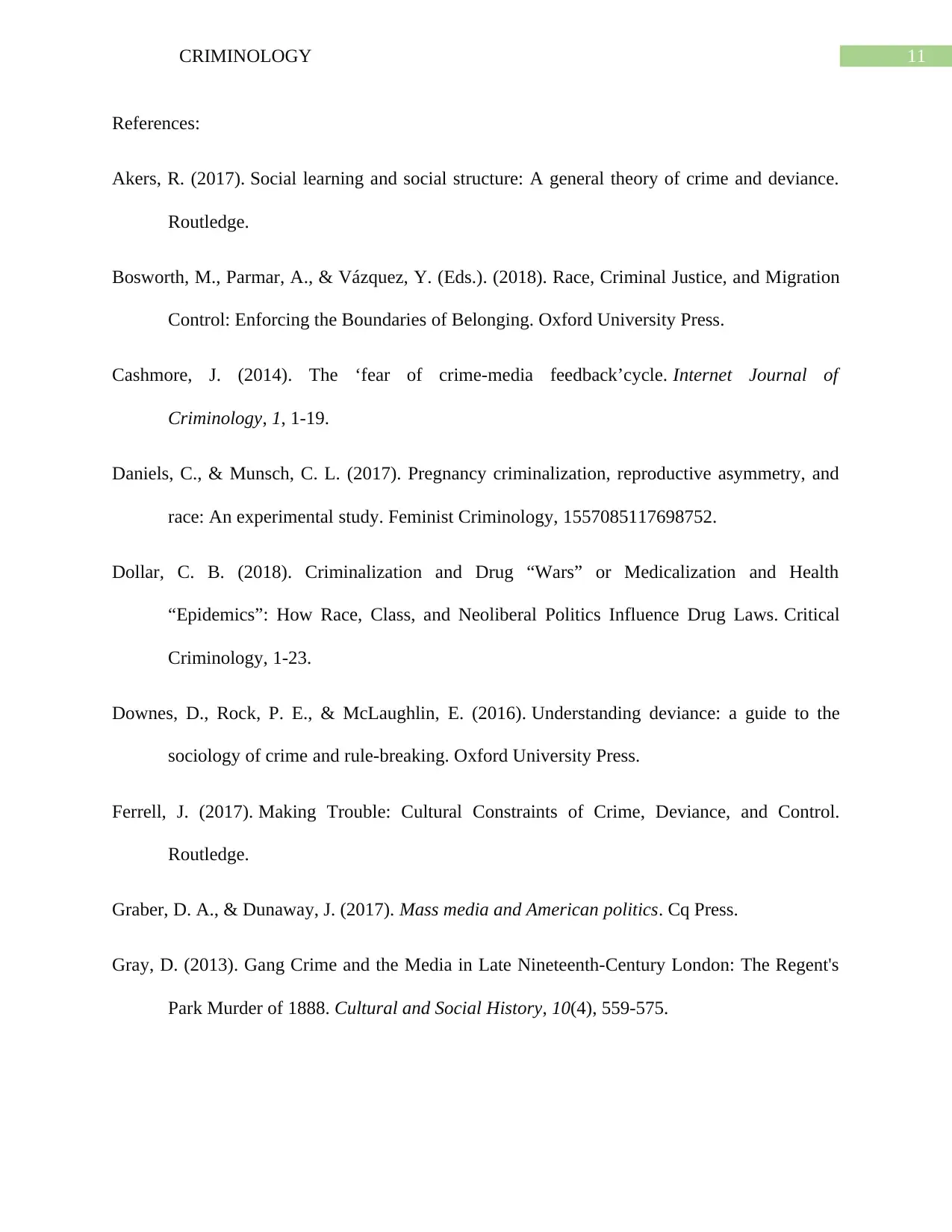
11CRIMINOLOGY
References:
Akers, R. (2017). Social learning and social structure: A general theory of crime and deviance.
Routledge.
Bosworth, M., Parmar, A., & Vázquez, Y. (Eds.). (2018). Race, Criminal Justice, and Migration
Control: Enforcing the Boundaries of Belonging. Oxford University Press.
Cashmore, J. (2014). The ‘fear of crime-media feedback’cycle. Internet Journal of
Criminology, 1, 1-19.
Daniels, C., & Munsch, C. L. (2017). Pregnancy criminalization, reproductive asymmetry, and
race: An experimental study. Feminist Criminology, 1557085117698752.
Dollar, C. B. (2018). Criminalization and Drug “Wars” or Medicalization and Health
“Epidemics”: How Race, Class, and Neoliberal Politics Influence Drug Laws. Critical
Criminology, 1-23.
Downes, D., Rock, P. E., & McLaughlin, E. (2016). Understanding deviance: a guide to the
sociology of crime and rule-breaking. Oxford University Press.
Ferrell, J. (2017). Making Trouble: Cultural Constraints of Crime, Deviance, and Control.
Routledge.
Graber, D. A., & Dunaway, J. (2017). Mass media and American politics. Cq Press.
Gray, D. (2013). Gang Crime and the Media in Late Nineteenth-Century London: The Regent's
Park Murder of 1888. Cultural and Social History, 10(4), 559-575.
References:
Akers, R. (2017). Social learning and social structure: A general theory of crime and deviance.
Routledge.
Bosworth, M., Parmar, A., & Vázquez, Y. (Eds.). (2018). Race, Criminal Justice, and Migration
Control: Enforcing the Boundaries of Belonging. Oxford University Press.
Cashmore, J. (2014). The ‘fear of crime-media feedback’cycle. Internet Journal of
Criminology, 1, 1-19.
Daniels, C., & Munsch, C. L. (2017). Pregnancy criminalization, reproductive asymmetry, and
race: An experimental study. Feminist Criminology, 1557085117698752.
Dollar, C. B. (2018). Criminalization and Drug “Wars” or Medicalization and Health
“Epidemics”: How Race, Class, and Neoliberal Politics Influence Drug Laws. Critical
Criminology, 1-23.
Downes, D., Rock, P. E., & McLaughlin, E. (2016). Understanding deviance: a guide to the
sociology of crime and rule-breaking. Oxford University Press.
Ferrell, J. (2017). Making Trouble: Cultural Constraints of Crime, Deviance, and Control.
Routledge.
Graber, D. A., & Dunaway, J. (2017). Mass media and American politics. Cq Press.
Gray, D. (2013). Gang Crime and the Media in Late Nineteenth-Century London: The Regent's
Park Murder of 1888. Cultural and Social History, 10(4), 559-575.
⊘ This is a preview!⊘
Do you want full access?
Subscribe today to unlock all pages.

Trusted by 1+ million students worldwide
1 out of 14
Related Documents
Your All-in-One AI-Powered Toolkit for Academic Success.
+13062052269
info@desklib.com
Available 24*7 on WhatsApp / Email
![[object Object]](/_next/static/media/star-bottom.7253800d.svg)
Unlock your academic potential
Copyright © 2020–2025 A2Z Services. All Rights Reserved. Developed and managed by ZUCOL.




